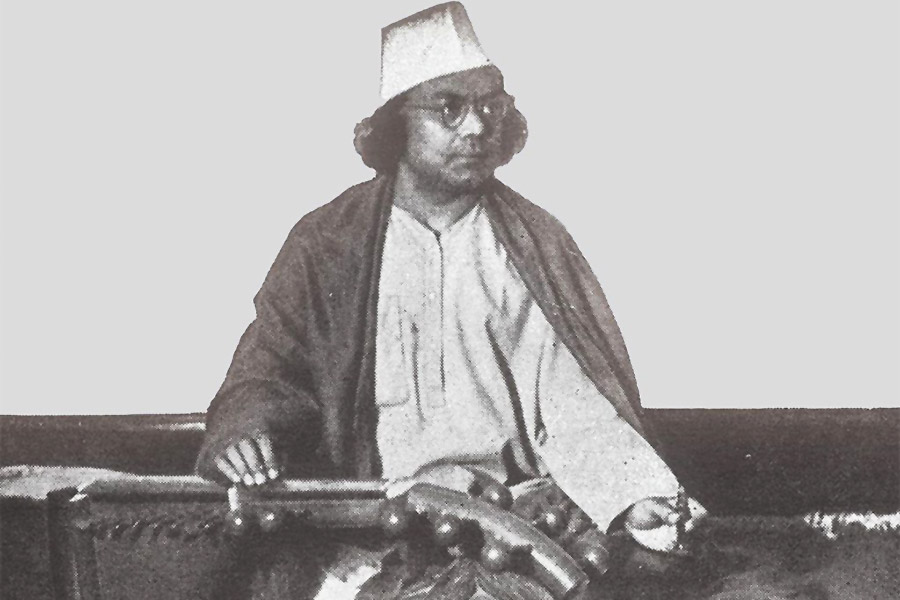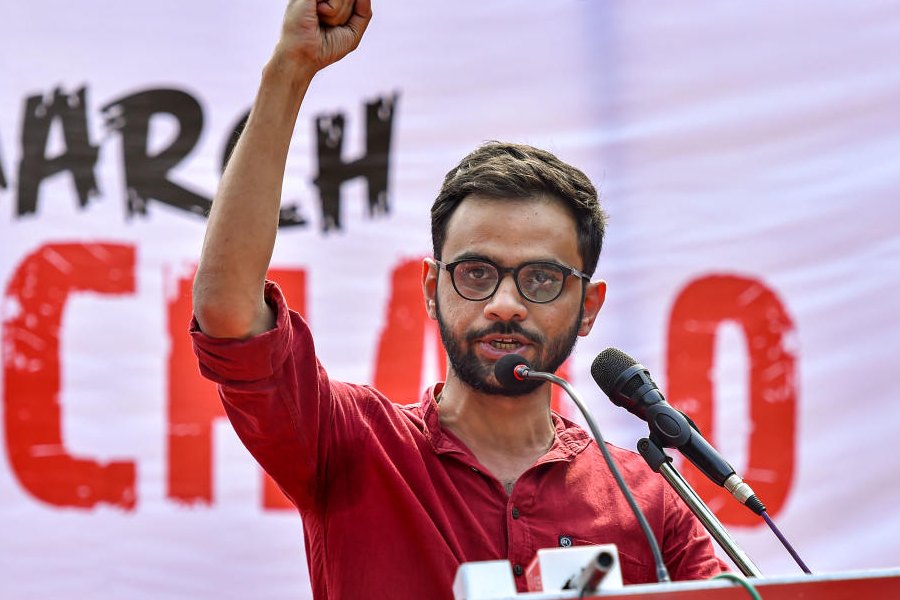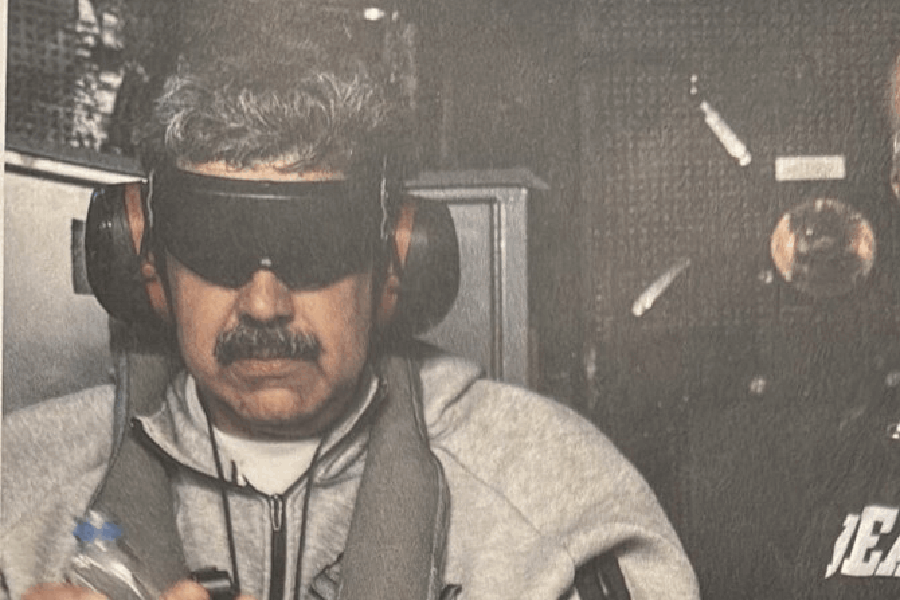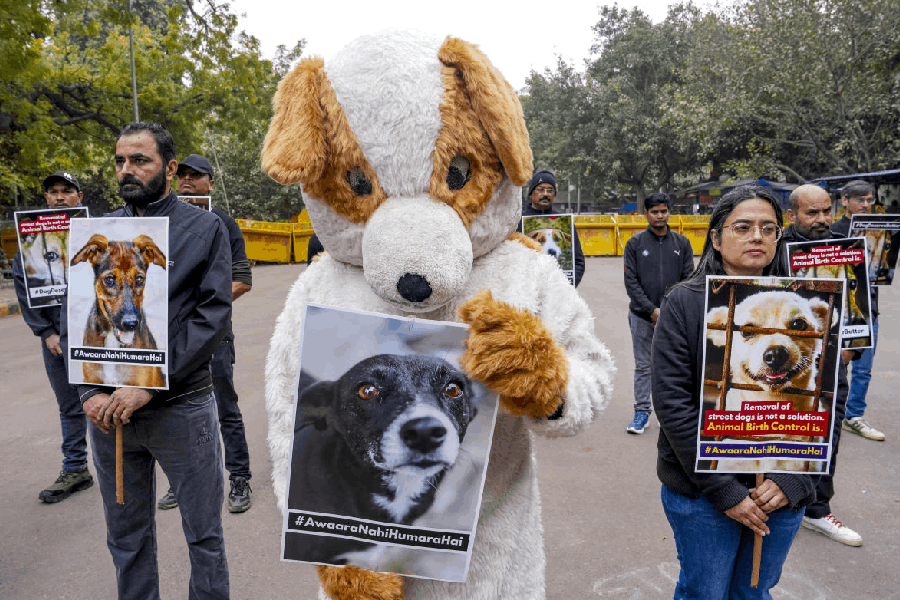The national poet of Bangladesh whose works inspired the country’s liberation struggle. A pioneer of the ghazal in Bengali, who introduced in his songs Urdu and Persian words. Composer and poet of some of the most evocative of love songs in Bengali. A Muslim who composed and wrote devotional songs addressed to Kali and Krishna that have few parallels in the language.
His compositions, known as Nazrulgeeti, are probably second only to Rabindrasangeet in the popularity they enjoy in Bengali households. His iconic revolutionary poem ‘Bidrohi’, published in the magazine Bijli, and his work as the founder-editor of the biweekly Dhumketu (1922) in which he was critical of the British Empire led to his arrest and being charged with sedition in 1923. So great was his influence that Rabindranath Tagore dedicated his play Basanta to him. He responded by writing the poem ‘Aj Srishti Shukher Ullashe’ to thank Tagore. Kazi Nazrul Islam, the rebel poet. One of the greatest figures in Bengali literature, second to none.
Kazi Nazrul Islam also had an interesting association with cinema over a period of eight years from 1934 to 1942. Like Tagore, he took to the art form in its nascent stages and engaged in it as a director, lyricist and composer. As Ashish Rajadhyaksha and Paul Willeman note in the landmark Encyclopaedia of Indian Cinema, composers like Anil Biswas ‘received early assignments as musician from Kazi Nazrul Islam at the Megaphone gramophone company’. They add that he was ‘one of the first composer-writers to sign contracts with major record companies in Bengal (for Megaphone and Senola and later HMV) and with the Indian Broadcasting Corp., opening up new employment opportunities to a generation of younger composers such as Anil Biswas, SD Burman, Kamal Dasgupta and even Kishore Kumar (whose song Ai Ek Dui Teen Char Gili Gili/Bam Chick Boob Chick Badhke Bol in Kehte Hain Mujhko Raja, 1975, adapts Nazrul’s famous ‘Chamchike ude gelo’).’
Nazrul made his directorial debut in 1934 with Dhrubo, sharing credit with Satyendranath. The film was based on the story ‘Bhakta Dhruv’, written by Girish Chandra Ghosh. He also acted in the film, playing Narada. He wrote and composed the 18 songs in the film (one song was written by Ghosh). Nazrul also sang three of the compositions in the film.
In 1937, he wrote the story, screenplay and dialogues for the New Theatres film Vidyapati, directed by Debaki Bose, based on the life and times of the Vaishnav saint and poet of the same name. The character of Anuradha (played by Kanan Devi) — the constant companion of the poet-saint — that Kazi Nazrul Islam created for the film became a landmark of the era.
Nazrul performed a comic role in the film Haal Bangla. He also created an urban variation of tribal jhumur music for Sailajananda Mukherjee’s Pataal Puri (1935), composed the music for Groher Pher (1937), wrote the songs for Nandini (1941) and Dikshuli (1943), and the screenplay for his novel Shapure (1938), which was later filmed in Hindi as well (Sapore). In 1942, he composed eight tracks, written by himself, for the film Chowrongi. According to Rajadhyaksha and Willeman, ‘He started Bengal Tiger Pics with Abbasuddin Ahmed. Their film of Nazrul’s novel Madina remained unfinished.’
In 1938, Nazrul courted controversy with his rendition of a Tagore song in the film adaptation of the Nobel laureate’s novel Gora for which he also composed the music. When Visva-Bharati objected to the way he had presented Tagore’s tunes, Nazrul took the film and the projector to Tagore at Santiniketan. Mesmerised by his rendition, Tagore is supposed to have exclaimed, ‘On what basis do they object to your take on my songs! Do they mean to say they understand my songs better than you do? Are they competent enough to do justice to my songs?’ He not only signed his approval of the songs but also blessed the project.
Nazrul’s works have been an integral part of films in Bangladesh for a long time. Zahir Raihan’s Jibon Theke Neya (1970) featured Nazrul’s ‘Karar Oi Louho Kopat’ as also Tagore’s ‘Amar Sonar Bangla’ (in defiance of a ban on Tagore’s songs imposed by Khwaja Sahabuddin, the information minister of Pakistan). The soundtrack of Humayun Ahmed’s Chandrokotha (2003) included Nazrul’s ‘Potho Hara Pakhi’. Nazrul’s novel Mrityukshuda was made into a series produced by BTV.
As the Daily Star Net reported, in 1989 ‘Nazrul’s Jiner Badshah was adapted for the silver screen project, which featured Bappa Raj. Three of Nazrul’s works — Meher Negar (2005), jointly directed by Mushfiqur Rahman Gulzar and Moushumi, featuring Ferdous and Moushumi; Rakkhushi (2006) by Matin Rahman, starring Rozina, Ferdous and Purnima; and Priya Tumi Shukhi Hou (2014) by Gitali Hasan — were adapted as films. Two children’s films were also produced by Bangladesh Shishu Academy from his poems ‘Lichu Chor’ and ‘Khuki O Kathbirali’.
Indian filmmakers and composers too have featured his works or their adaptations in films both Hindi and Bengali. The important ones include:
Chokh Gelo, Chokh Gelo (Nandini, 1941, Bengali)
SD Burman’s association with Nazrul has been well-documented. After his experience with the songs he had sung for New Theatres’s Nitin Bose directorial Yahudi Ki Ladki (1933) – the composer Pankaj Mullick removed the songs SD had rendered and had Pahari Sanyal sing them again – SD decided on two things: that he would sing only his own compositions (not songs composed by anyone else) and that he would not lend his voice to any actor; his songs would appear as background narrative to comment on a situation.
The only exception he made to this — apart from his son RD Burman’s composition Doli Mein Bithayi Ke in Amar Prem — was Nazrul. His old friend from Comilla, Himangshu Dutta, was composing the music of Nandini (1941), directed by Sailajananda Mukherjee. Kazi Nazrul’s ‘Chokh Gelo, Chokh Gelo’ featured in the soundtrack and Nazrul wanted SD to sing the song. There was no way SD could refuse his ‘favourite Kazi Da’. It remains the only song in Bangla and Hindi cinema, barring RD’s in Amar Prem, that SD sang that was not his own composition.
Poochho Na Kaise (Meri Soorat Teri Aankhen, 1963, Hindi)
This incomparable Ahir Bhairav composition immortalised by Manna Dey was based on Nazrul’s classic Arunokanti Ke Go Jogi Bhikhari. The finest of its many renditions in Bengali is by Manabendra Mukherjee. In the Hindi version, SD’s understated music allows Manna Dey’s voice to take precedence even as the melody rises to its overwrought note. The symbolism of light and darkness, hope and despair that is so much a part of the mise en scene — the shadows cast by the roof, lanterns, skylight, the oil lamp — are reflected in Shailendra’s beautiful words. All these add up to create one of Hindi cinema’s finest numbers.
Roz Akeli Aaaye (Mere Apne, 1971, Hindi)
Gulzar’s words likening the moon to a beggar’s bowl in the hands of the vagrant night work magic in this song composed by Salil Chowdhury. The song was supposed to be shot on Meena Kumari but her illness put paid to those plans. Interestingly enough, among the many renditions of the song in Bengali (which takes recourse to Arabic music) — Meghla Nishi Bhore — is one by SD Burman.
Shaono Raate Jodi (Devdas, 1979, Bengali)
Another Manna Dey classic, this Nazrul composition found its way in this Bengali adaptation of Devdas, starring Soumitra Chatterjee in the titular character and Uttam Kumar as Chunilal. Few songs convey the despair of love on a rainy night as evocatively as this. The poet’s wonderful wordplay — ‘bahire jhor bohe, nayane baari jhore’ (the storm raging outside juxtaposed against the torrent pouring from the eyes) finds Manna Dey’s brilliant vocals in this composition based on Raag Charju Ki Malhar.
Shunyo E Buke (Agaman, 1988, Bengali)
Exquisitely rendered by Haimanti Shukla and extremely well emoted by a resplendent and understated Debashree Roy, this Nazrul song, set in Raag Chhayanat, articulates the agony of lost love, imploring its return. It is the highlight of this 1988 romantic melodrama directed by Tarun Majumdar starring Soumitra Chatterjee and Tapas Pal. What makes the song work wonderfully well is the way the director uses it as the motif of the film’s theme. In an otherwise uneven film, I still recall the sense of pathos the song creates.
(Shantanu Ray Chaudhuri is a film and music buff, editor, publisher, film critic and writer)











